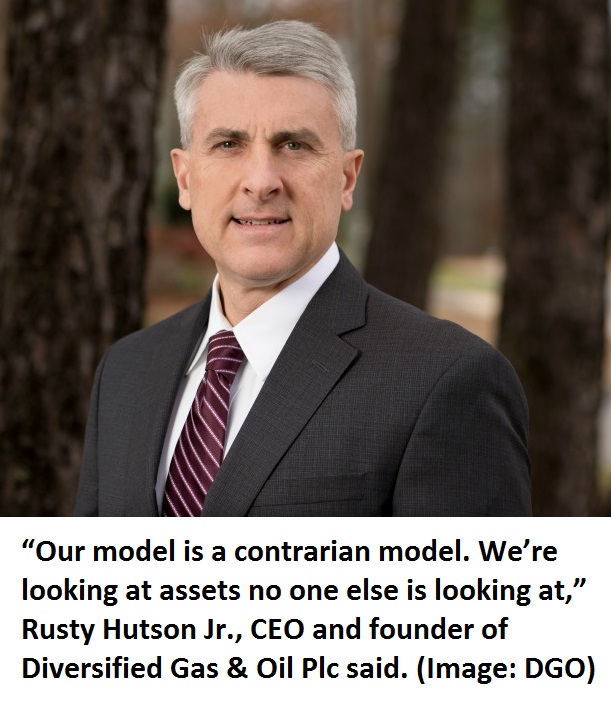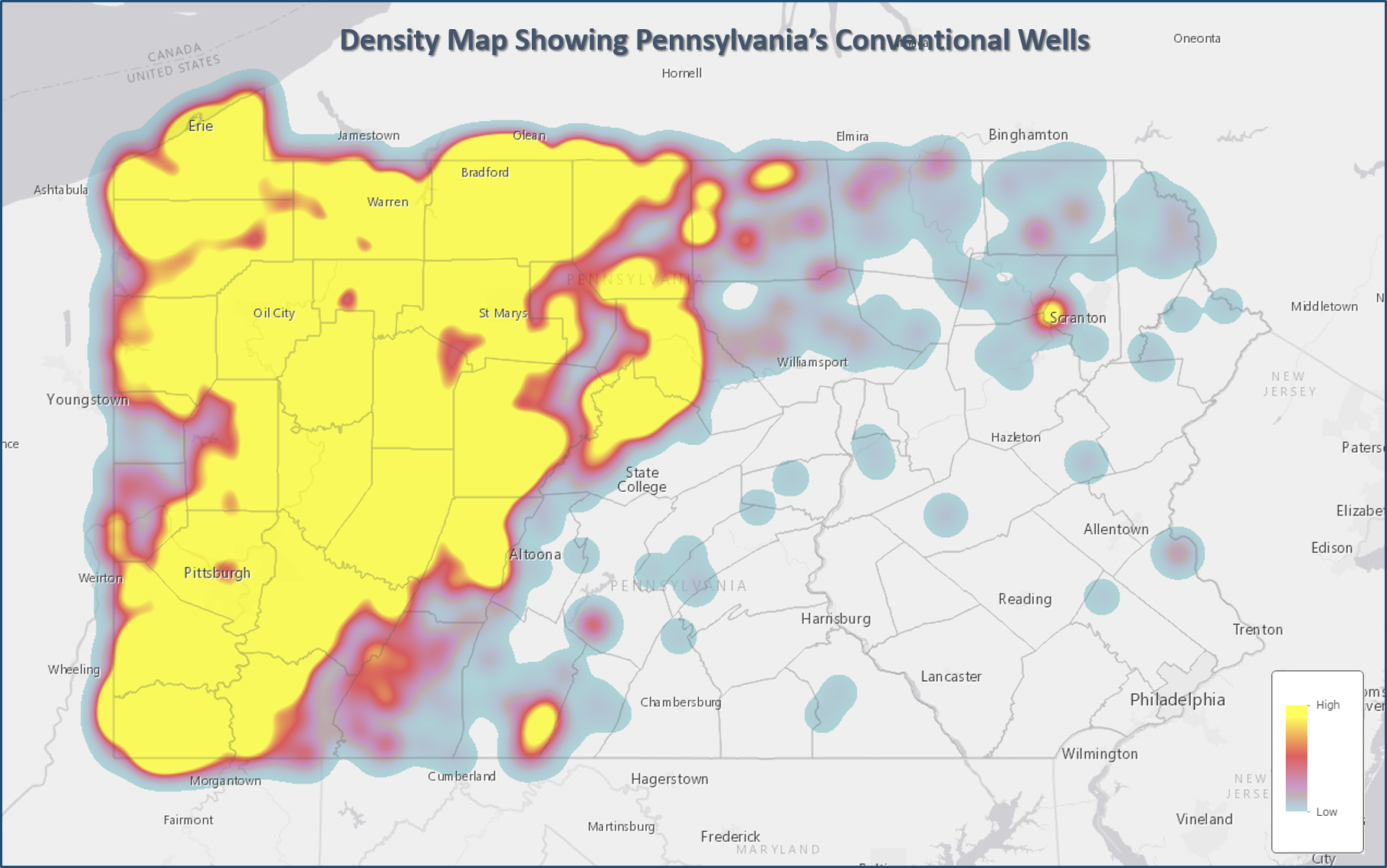
Diversified Gas & Oil targets conventional legacy Appalachian wells to increase production and lower overhead—while spending less annual capex than the cost of a single Permian well. (Image: Hart Energy)
Rusty Hutson Jr., CEO and founder of Diversified Gas & Oil Plc (DGO), has taken to explaining his company’s natural gas business to investors in an unconventional way.
The company relies on legacy conventional wells no longer wanted by other E&Ps focused on shale plays. DGO’s projections seem a bit too good to be true—up to 40% EBITDA margins on mature, natural gas production from vertical wells on a steady, inexorable decline.
Hutson puts it to potential backers like this: “We’re boring, and we like it that way.”

DGO sees legacy assets as a safe bet for consistent cash flow, relying on natural gas wells that are producing steady, predictably declining production.
“Our model is a contrarian model,” he said. “We’re looking at assets no one else is looking at.”
In March, DGO closed on two deals: the acquisition of Alliance Petroleum Corp. for $95 million and, at the end of the month, a second deal with CNX Resources Corp. (NYSE: CNX) for $85 million.
Between the two deals, the company added 107 million cubic feet of gas equivalent per day (cfe/d) and 2.4 million undeveloped HBP acres.
The Birmingham, Ala.-based company and only a few others are E&Ps minus the exploration. They buy legacy Appalachian gas production. And even in those has-been, outdated wells there’s still a lot of life and money left. The companies also don’t spend much, if anything, on drilling and keep capex to a minimum.
Lately, more shale-oriented companies have been tempted by the allure of shale returns, which only opens more opportunities for companies like DGO such as Denver-based Carbon Natural Gas Co.
“It takes the same amount of people to operate a thousand of these wells as it does 5,000,” Patrick R. McDonald, Carbon’s CEO, said last June at Hart Energy’s DUG East conference in Pittsburgh. “Obviously your per unit cost is better and your per unit G&A is better if you have 5,000 or 10,000 or 15,000 of these shallow gas wells.”
DGO’s acquisitions are aimed at gaining scale that allows the company to “realize operating efficiencies, enhancing our operating margins,” Hutson said.
In Appalachia, the rapid ascendancy of the Marcellus Shale as a natural gas king reversed the polarity of the region. The older vertical wells became an afterthought.
In Pennsylvania, about 7,100 unconventional wells produced 5.1 Tcf of gas in 2016, according to the state’s department of environmental protection. Conventional wells lazily sighed 107 Bcf from about 56,700 wells.
“The larger companies began losing interest in operating conventional production wells in Appalachia,” Hutson said.
Despite attention and money given to the Marcellus and other gas plays, the sheer number of vertical wells still offers formidable legacy production.
As Hutson witnessed the Marcellus Shale starting to take root, he saw an opportunity.
Conventional Contrarian
Hutson is the product of three generations spent toiling in the oil and gas industry. His great-grandfather, grandfather and father spent decades working the oil patch.
During the summers, particularly in college, Hutson’s father insisted he work in the field, digging up fields for future pipelines. His studies put him on a career in banking and finance, perhaps motivated by the desire to avoid digging those ditches.

Despite the importance of his oil and gas lineage to him, DGO’s founder views everything his company does through a financial lens.
“We’re looking to get the highest return on capital that we can get,” he said. “It could be anything, really—it just so happens that these are oil and gas assets.”
It wasn’t until 2001, that Hutson’s father showed him a package of wells for sale in West Virginia. Still working in corporate banking positions, he secured rights to the wells through financing from the owner, borrowing the rest of what he needed through a home-equity.
“My wife was ready to kill me at the time,” he recalled.
By 2014, with the Marcellus siphoning off interest in conventional production, Hutson’s business model expanded. It was an equation with just one missing variable: money.
Amidst a downturn, DGO was too small to entice private-equity investments and banks had battened down on lending. A friend suggested Hutson try the London stock exchange. In 2015, the company successfully listed a $13 million corporate bond in London on the ISDX Growth Market.
“We used that money to acquire Eclipse Resources’ assets in Ohio and Seneca Resources assets in Pennsylvania,” he said. The company acquired about 3,500 wells in two transactions totaling $8.4 million.
In February 2017, DGO successfully launched a $50 million IPO on the London Stock Exchange. The IPO was the largest for an oil and gas company in the U.K. since 2012 and perhaps the first conventional company to go public since Pacific Coast Oil Trust in May 2012.
Golden Idle
Investors have apparently seen the good in being “boring.”
The company started off 2017 with the purchase of 1,300 producing wells from EnerVest Ltd. for $1.75 million. It followed with an acquisition of Titan Energy LLC’s 7,300 producing gas and oil wells for $35 million.
DGO’s stock in London is up by roughly one-third since its debut about a year ago.
As tight oil and gas plays have come to dominate deals, potential sellers are starting to recognize DGO as a bulk buyer of the legacy assets they no longer want.
DGO’s overhead expenses decrease with each new acquisition. At the end of 2017, the company’s unit cost per Mcfe was roughly $1.24. With its deals with Alliance and CNX, unit costs will drop by about 13% to $1.08 while increasing production, Hutson said.
“We have been very successful in not only increasing production but definitely decreasing the operating cost per unit,” he said.
DGO essentially pumps out cash flow while looking to acquire other businesses and returns that fit. Hutson acknowledges that may sound like an MLP.
The difference is that DGO is buying at the “bottom of the spectrum” with acquisitions at about 4x cash flow, he said. The company also isn’t adding high levels of debt.
“The MLPs weren’t able to do that,” he said. “MLPs were just, unfortunately, buying assets at a much higher commodity price leaving them exposed to downside pressure.”
DGO also tucks new acquisitions into a geographically-concentrated area. It then squeezes efficiencies and costs out of what it buys.
Even a good scrub can help production.
“A lot of time the wells have been neglected. They haven’t been taking care of. We’ll go in, clean them up, clean out the rigs to get the production levels up,” he said.
DGO’s well tenders also optimize visits to meters depending on production levels. High producers are visited often while others may only require inspection once a month.
In January, DGO went to the London stock exchange seeking to raise $100 million of equity for its Alliance and CNX acquisitions. The company instead netted nearly $290 million.
“We’re able to fund these transactions purely with equity, which really gives us a lot of running room on the debt side to find further acquisitions,” Hutson said.
While shale E&Ps showcase high rates of return for investors, many are forced to plow money back into drilling. DGO’s philosophy is to use cash flow to pay interest expenses, taxes and return a dividend, which in 2017 paid a 4.3% yield, said Eric Williams, DGO’s CFO.
The company plans to operate nearly 30,000 producing with less capex than most E&Ps spend drilling and completing a single well. DGO’s limited capex is set high enough to buy replacement trucks for well tenders.
“It’s not the typical E&P story,” Williams said.
Darren Barbee can be reached at dbarbee@hartenergy.com.
Recommended Reading
CEO: Continental Adds Midland Basin Acreage, Explores Woodford, Barnett
2024-04-11 - Continental Resources is adding leases in Midland and Ector counties, Texas, as the private E&P hunts for drilling locations to explore. Continental is also testing deeper Barnett and Woodford intervals across its Permian footprint, CEO Doug Lawler said in an exclusive interview.
To Dawson: EOG, SM Energy, More Aim to Push Midland Heat Map North
2024-02-22 - SM Energy joined Birch Operations, EOG Resources and Callon Petroleum in applying the newest D&C intel to areas north of Midland and Martin counties.
CNX, Appalachia Peers Defer Completions as NatGas Prices Languish
2024-04-25 - Henry Hub blues: CNX Resources and other Appalachia producers are slashing production and deferring well completions as natural gas spot prices hover near record lows.
US Gas Rig Count Falls to Lowest Since January 2022
2024-03-22 - The combined oil and gas rig count, an early indicator of future output, fell by five to 624 in the week to March 22.
US Drillers Cut Oil, Gas Rigs for Fourth Week in a Row-Baker Hughes
2024-04-12 - The oil and gas rig count, an early indicator of future output, fell by three to 617 in the week to April 12, the lowest since November.




